Many readers might have been wowed by Arthur C. Clarke’s depiction of humanity’s post-human future in Childhood’s End. For me, the wow moment was this:
The important fact was that I knew how far they had to travel, and therefore how long the journey took. NGS 549672 is forty light-years from Earth. The Overlords ships reach more than ninety-nine per cent of the speed of light, so the trip must last forty years of our time. Our time: that’s the crux of the matter. (…)
From the viewpoint of the passengers on one of the Overlord ships, the journey to NGS 549672 will last not more than two months—even though by Earth’s reckoning forty years will have passed.
As my piece on Bussard Ramjets should have made clear, I love stories in which nearly-as-fast-as-light travel and the attendant time dilation are significant plot elements. Even if the plot doesn’t entirely make sense, the idea of polities that somehow manage to remain in contact with each other despite gulfs of time and space, of people skipping forward through history, will always convince me to give the work a look.
(It’s just this sort of clear-eyed focus on important things and my eagerness to share my thoughts at length that keeps people from inviting me to parties. To think of all that they are missing!)
Here are a few of the time-dilation novels (and one song) that come to mind:
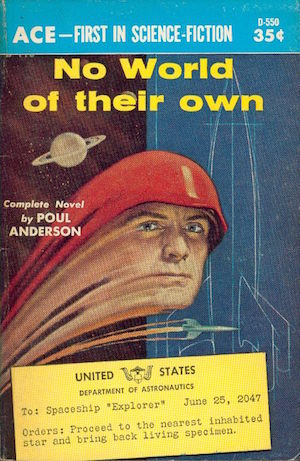
Poul Anderson’s The Long Way Home (published in 1955 as No World of Their Own) is a fine example of what sort of book I will read just to get my time-dilation fix. Believing that they are in possession of a faster-than-light drive, four American astronauts set off on a five-thousand-light-year exploratory voyage. Just one small catch: the drive is actually only speed-of-light, and it is only instantaneous from the perspective of the travellers. By the time the quartet returns home, five thousand years have passed. The USA is gone; every person the four knew is dust.
This novel fails to make sense in so many ways.
- The US believes that they have found a loophole in the theory of relativity. Input from actual physicists seems to be missing.
- Researchers never noticed that the test probes moved only at lightspeed, not faster.
- The US decides to test their crewed starship with an epic journey rather than a quick bounce to Pluto (which would have revealed the flaws in their reasoning).
The book is sexist as well. When it was reprinted in 1978, times had changed; author Anderson wrote a defensive introduction to the reprint, on the order of “Well, the future society is supposed to be bad!”
Incoherence and sexism aside, there’s something to like here. I liked, and still like, the speculation as to how trade and government might work when human-settled planets are so far separated. I read this work over and over back in the Disco era.
Brian May (of the rock group Queen) has a PhD in physics, an interest which has demonstrably influenced his music. Take 1975’s “39” (found on the album A Night at the Opera). Hopeful explorers set out in a starship. For the voyagers, a year passes; for their friends and families at home, a full century. The homecoming is not the happy celebration the explorers had expected.
One has to wonder how this could possibly have come as a surprise to the travellers. Surely time dilation was covered in the mission briefing? But perhaps it was in a footnote. (Nobody ever reads those.) Arguably the May piece is even sadder than the Anderson novel. In the novel, everyone who knew the astronauts is dead. In the music, some of those left behind have survived. One imagines they have lived with betrayal and despair, which misery they share with the returning explorers.
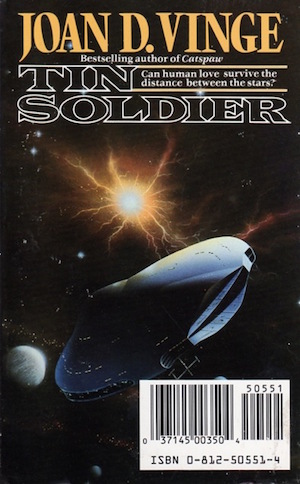
No hope for men with pretensions of following in Captain Kirk’s footsteps in Joan D. Vinge’s 1974 novella Tin Soldier (originally collected in Orbit 14, later reprinted in Eyes of Amber). Starflight is the exclusive domain of women; men, physiologically incapable of serving as waking crew, are consigned to the status of hibernating cargo. The story follows an intermittent romance between two people: a woman whose career as crew leaves her skipping across decades and her immortal cyborg bartender friend, who is making his way through time the slow way.
It is all too common for men to regard woman-dominated fields as therefore of minimal importance and deserving minimal pay. In Vinge’s setting, this is not so. I liked that bit, but it’s not the point of the story. The relationship between star-farer and bartender is.
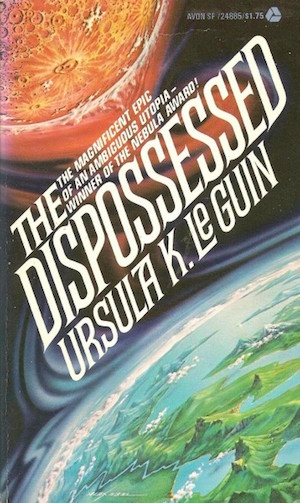
Le Guin’s 1974 The Dispossessed takes place in her Hainish setting, where living beings are limited to Nearly As Fast as Light Travel1. Many Hainish stories feature ansibles, communication devices not limited by the speed of light. The Dispossessed is the story of the man who invented the ability to speak across interstellar gulfs. Perhaps not entirely coincidentally, this is also the story of his journey between planets and cultures.
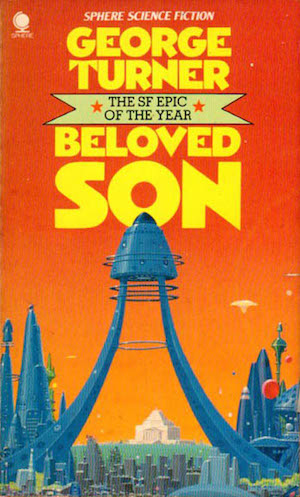
Beloved Son is the first volume in George Turner’s Ethical Culture trilogy. The crew of the Barnard star expedition did understand the implications of relativity. They did not envision how dramatically Earth would have changed in just forty years, courtesy of a civilization-levelling nuclear war. Gone, the blind rivalries that killed billions—in their place, the great international Ethic intended to provide a stable sane world. Commander Raft and his companions will test that stability.
Turner completely flubs the math on a NAFAL round trip to Barnard’s Star. Ah, well. His new world order draws on various tropes that will be familiar to long-time SF readers; what’s impressive is how quickly even the most steadfast adherents of the Utopian Ethic toss it overboard as soon they think they can gain a momentary advantage over their rivals.
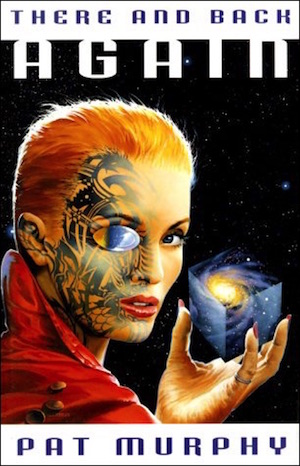
Pat Murphy’s 1999 There and Back Again has faster-than-light travel thanks to a network of wormholes left by a now vanished alien race, with two catches: the aliens didn’t leave a map of their network, and the wormholes only allow passage in one direction. Protagonist Norbit Bailey has no interest in starfaring, but is shanghaied into an unrequested life of galactic adventure.
This was clearly inspired by a well-known tale of a comfortable little man dragged out of his comfortable home and subjected to wilderness camping, trolls, and encounters in the dark. But this exuberant romp is so much more than a one-to-one mapping of fantasy to science fiction. It’s fun. It’s also very thoroughly out of print, boo hiss…
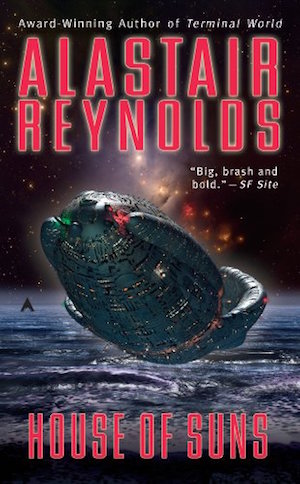
In Alastair Reynolds’ 2008 House of Suns, civilizations abound butplanet-bound civilization is all too mortal, blooming and collapsing over mere millennia. The space-faring Lines provide long-term stability, thanks to their use of relativistic travel. What was intended as a millennial family gathering for the Gentian Line takes a much darker turn when two Gentian clones arrive late to the 32nd Gathering and discover that their relatives have been murdered. Who dunnit and why are obscure. What is clear is that the unseen player on the other side intends complete annihilation of the Gentian Line.
Reynolds embraces the scale of his setting with a plot that spans galaxies and tens of millennia, and a history longer than hominids have existed on Earth. A fine example of a time-dilation novel.
These are, of course, just of few of the time-dilation novels I have enjoyed. I’ve read a lot over the years, but not everything. What do you think should be on this list? Tell us in comments.
In the words of Wikipedia editor TexasAndroid, prolific book reviewer and perennial Darwin Award nominee James Davis Nicoll is of “questionable notability.” His work has appeared in Publishers Weekly and Romantic Times as well as on his own websites, James Nicoll Reviews and Young People Read Old SFF (where he is assisted by editor Karen Lofstrom and web person Adrienne L. Travis). He is surprisingly flammable.
[1]Well, except for the stories where they aren’t. I can never follow what’s going on in the Le Guin tales featuring FTL-enabling Churten theory.










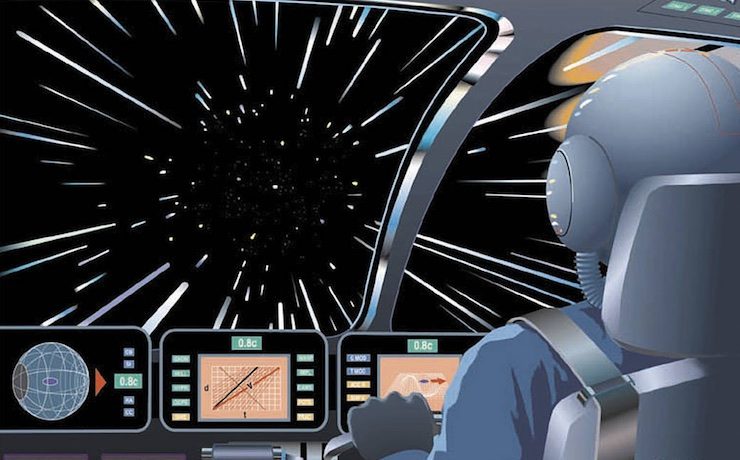
Clearly, Joe Haldeman’s The Forever War.
The song was obvious as soon as you mentioned there was one. I was expecting one of the novels to be Heinlein’s Time for the Stars, where time dilation is made clear to the intended juvenile audience through the different aging of the twins who are used as telepathic FTL communications devices.
Anderson’s Kith series also uses time dilation as a plot point. That’s only 4 stories over 44 years, but possibly worth noting. His novel Tau Zero also features time dilation. Hmm, he seems to have made use of it quite a bit.
Also, James’ byline seems to be missing from the top of the article.
There’s an earlier Haldeman, “Time Piece”, that reads like a trial run for the Forever War.
NAFAL trade must be pretty tricky and may imply technological development has leveled off. If not, there’s every chance one will arrive with a cargo full of sliderules at a planet with pocket calculators.
I recommend the Ken MacLeod Engines of Light trilogy. It uses a Fast As Light drive and takes place thousands of light years from Earth. Not that anyone is going back to Earth anytime soon. The stories revolve around the different worlds of the Second Sphere and take into account the fact that it takes time for travelers to get to one world from another.
How do you not mention The Forever War? Also the Three Body trilogy uses the speed of light, and physics in general, in some very well-done ways.
A Deepness in the Sky might or might not be worthy of mention. The slower-than-light travel is not the focus (snrk) of the plot, but it is significant in the … framing? background? … story.
It’s been quite a while since I read it that series, but doesn’t Stross’ _Singularity Sky_ have something like “Yes, there’s FTL travel, but there are also immensely powerful beings who will smack you down if you use it in their causality cone”? IIRC, that leads to near-c travel being used instead.
How can you have included a novel by Poul Anderson and it not have been Tau Zero – the most extreme time dilation novel it is possible to write.
In _Singularity Sky_ (and related novels), the Eschaton wasn’t opposed to FTL per se, only use of FTL which resulted in time travel which threatened its own existence. It also used subtle sabotage if someone tried to otherwise use FTL as a time machine.
NAFAL was thus safer on general principles.
To non-anglosphere cents: Return from the Stars, by Stanislaw Lem and Noon: 22nd Century, by A. & B. Strugatsky.
I mentioned Tau Zero and The Forever War in earlier essays. I try not to repeat myself.
I am saving Time for the Stars for my follow-up: Five (or Six) SF novels that got relativity hilariously wrong. Although Farmer in the Sky might be a better choice.
I assume The Sparrow will also be on that list of novels that got relativity hilariously wrong?
In “’39”, I never got the impression that they were surprised by the time dilatation itself, but by the strength of their own emotional reaction to it.
And that’s not the only time dilatation/love song! “Benson, Arizona” is always paired with it in my mind. It was written by John Carpenter (lyrics by Bill Taylor) for his early film Dark Star, though I first encountered it in a cover by filk group Clam Chowder.
The ender’s saga has all sorts of relativistic elements through out the series. Several plot points hinge on relativistic travel and FTL communication.
@11: Please consider A Gathering of Stars (Donald Moffitt) for your hilarity followup.
Moffitt’s Second Genesis makes use of a (very improbable) NAFAL drive, with long-absent humans returning from another galaxy to a star system near Earth after (I think) millions of years; but there’s no actual time dilation happening within the plot — it’s just background.
Larry Niven’s A World Out Of Time relies on time dilation for a fair amount of plot. I think maybe you touched on it in your ramscoop article.
Charles Sheffield’s Between the Strokes of Night has a new twist on this: the “Immortals” travel slower than light, but they live at a tiny fraction (I think one fiftieth) of the speed of ordinary humans, so they can easily travel between stars during their lifetimes. Time dilation is a daily fact of life to them.
Although the only travel he engages in is to the neighboring planet, of which is world his the moon. So this is kind of an odd choice, given that there’s no relativistic travel or time dilation.
Niven’s World of Ptavvs had the Thrintun using slower than light vessels (in between FTL jaunts) – and this is a species that is so unintelligent enough that although they are aware of time dilation, this fact slips their minds regularly (the main thrintun character never figures out why his watch is wrong after a trip).
Time dilation plays an important role in some of Le Guins early stories: Semley’s Necklace and Winter’s King. And her 1994 story Solitude gives some insight into the way people deal with time dilation in an interstellar society based on NAFAL travel: “‘You know, if you stay and I go, we’ll be dead.’ That was how the young people of the ships said it, when one was going to cross the lightyears and the other was going to stay. Goodbye, we’re dead. It was the truth.”
Alastair Reynolds plays with time dilation in his Revelation Space series as well., mainly to strand characters far, far from home and make a return trip an exercise in futility.
Ian Douglas uses it once in his Andromedan Dark series, but it’s a doozy as it advances the ship millions of years into the future.
Nobody, including the characters, seems to really understand what’s going on in the Le Guin stories that involve the churten drive. That feels vaguely appropriate, given that the stories are set in what is otherwise a relativistic universe (I think time dilation in NAFAL travel implies General Relativity holds), and GR, FTL, and causality may be a “pick at most two” threesome.
Probably not really time dilation, not in the physical sense, but the song “Clouds Across the Moon” is an Earth woman calling to her partner who is in the war zone on “Mars flight 2-4-7″… in real time… with a kicker that she gets to call once a year.
Since we don’t get his (?) side of the conversation, it could be that she’s hearing his side of the previous year’s call.
And I just noticed the significance of the artist name – “The RAH Band”. Heh. Standing, of course, for Richard Anthony Hewson – who… is “The RAH Band”; all of it. You know, like in that story –
Speaker for the Dead, by Orson Scott Card.
It’s been a very long time, but I recall F.M. Busby’s work dealt with how relativity plays with time. In fact, I think one of the novels was called The Long View, which, IIRC, was a reference to how space travelers went away for a very long time.
And Greg Egan turns relativity inside out in his Orthogonal series. In that reality, the clocks of moving objects appear to run faster rather than slower!
23 comments in and nobody mentioned “Pushin’ the Speed of Light” by Ecklar & Prather yet? Man, I am old.
And your friends are gone and your lovers too
And there’s damn-all left that you can do
And you try to lie, but you know it’s true, pushing the speed of light
Pushing the speed of light
So you sign back on for another run of pushing the speed of light…
https://www.youtube.com/watch?v=ud6LiVJkwyA
TIMEMASTER by Robert L. Forward is a story of a multibillionaire who harnesses a space lifeform called a Silverhair, which has the property of being stretched, but no distance is travelled if you push things in one end, they instantly come out the other. The rich man exploits that to create a ship moving at relativistic speeds but uses a Silverhair to maintain contact with the now back on Earth, eventually coming back to his starting point and expanding the Silverhair to make “time-tunnels” that move no net distance in space but move you years in time. But his trip among the stars is not without perils and assistance from…older versions of himself.
Being an inveterate filker, I assumed the song was this one.
Karl Schroeder’s YA novel Lockstep is a great example of how a galactic civilisation can flourish in a slower-than-light travel universe.
I’ve always imagined ’39 as a “forgotten lore” folksong, in that the people singing it don’t seem to understand what it’s about, and have—for example—replaced the Way in Milky Way with the word Sea, even though that doesn’t rhyme. Because a Sea is something you sail across, and that’s the level of tech they still understand.
Admittedly, some of this idea is based on the fact that the woman who introduced me to the song hated science fiction, and flat-out refused to believe that it was anything more than a lovely ballad with some odd metaphors.
Jo Walton’s Lifelode has time dilation across a world.
I was expecting the song to be van der Graaf Generator’s Pioneers Over c, from their album H to He, Who Am the Only One. The inner sleeve of that album had an accurate description of the fusion of hydrogen to form helium – they were just like that.
@29 — Lifelode is wonderful. The idea central to it reminded me a lot of the great David Masson story “Traveller’s Rest”.
Tau Zero. Poul Andersen at his very best. Actually made me learn relativity to understand the math
Why does Time for the Stars get relativity hilariously wrong? I think Heinlein wrote that very fine book after having read Sir Arthur Eddington’s The Nature of the Physical World and having understood its description of the fundamental reason for the twin paradox (which is the 4D Minkowskian analog of the triangle inequality). At the end of TftS, Heinlein does circumvent, or rather cancel, general relativity completely; but that is fully allowed within the licence of SF.
And what was relativity-wrong in Farmer in the Sky anyway? I think you mean Starman Jones. That book does indeed completely ignore relativity special and general – and it’s a very fine yarn for all that.
Essay covering TFTS and FITS coming!
Not a giant novel by any stretch, but time dilation plays a rather prominent role in Spider Robinsin’s “completion” of Heinlein’s “Variable Star”.
This might be cheating, but there are two works of Japanese animation that tell interesting stories using time dilation. There’s Gunbuster from Hideaki Anno (Evangelion), and Voices of a Distant Star from Makoto Shinkai (Your Name)
I haven’t seen Evangelion but Voices doesn’t use time dilation. The lag is caused by a combination of one-way FTL jumps, each farther from Earth, and light-speed communications systems. If the fleet knew how to get back to Earth, their clocks would agree with each other’s.
@23. wyrdsmythe beat me to it, but F. M. Busby’s “Star Rebel” blew my 10 or 11 year-old mind with discussions of relativistic travel.
A. E. van Vogt’s short Far Centaurus has sort of a reverse twist on time dilation. But that involves FTL travel being developed in the meantime. And there’s a fluke at the end that leads to time travel as well…
Also kind of a funny bit involving personal hygiene.
Busby’s an odd author for me. I always feel like I should have enjoyed his books more than I did.
Dan Simmons’ novel Hyperion, in particular the chapter “Remembering Siri” which also published separately as a standalone short story. It’s told in flashbacks, covering all the times the protagonist returns to a planet to visit his love, who is older each time. (The present day is her funeral.) That’s the core of the story but there’s more, and time dilation is key.
@james You’re right about Voices – I forgot about that. With Gunbuster (not Evangelion – I should have written that better) – it’s more clearly related to Time Dilation.
Spoilers for Gunbuster.
A recurring plot point relates to our protagonists, Noriko and Kasumi, ending up more and more psychologically separated from their High School classmates (who didn’t make it into the the Buster program), as they keep getting sent on missions in the titular super robot while their classmates grow old and develop families on Earth – to the point that Kasumi basically ends up becoming close to their Coach because for the first chunk of the series he’s on the carrier with them, which means he’s become one of the few constants in their lives – with the drama of one of their episodes being that on one mission the Coach can’t come on the command ship because he’s got cancer and is dying – with the ticking clock being “can we complete this mission before Coach succumbs to cancer.”
This basically ultimately comes to a head in the climax of the show – for Noriko and Kasumi, it’s basically only been a few months since they were recruited into the Buster program in High School. Their classmates who didn’t qualify, by this point, are parents, with children who are coming up on the same age as our protagonists at the start of the series – with the question being for the protagonists if they can fit into a society that they feel so very out of place from – similar to what they left behind, but still very different, or whether they go back out for one last mission.
C. J. Cherryh’s Alliance/Union novels deal with the early “sublight” ships – both as immediate reality, in Heavy Time and Hellburner, and as a part of history that many people still living can remember even though all of the ships have been converted to ftl drive.
Many of Le Guin’s novels and short stories set in the Hainish universe deal with the time-dilation effect of the NAFAL drive – Nearly As Fast As Light, an acronym so good I always want to steal it. The Dispossessed, however, mostly doesn’t: Shevek can leave Anarres and return still in the same time zone.
IIRC, John C. Wright’s ‘Count to the Eschaton’ series involves the hero’s waiting out a millennia-long lapse while his girlfriend makes a NAFAL journey.
Rick Ellrod
Frederik Pohl’s Gateway. Although mentioning it as an example of time dilation does introduce something of a spoiler.
I’ve been enjoying sci-fi and fantasy for several decades.
To The Stars by L Ron Hubbard. (aka Return to Tomorrow)
It is considered one of his best.
Probably the only novel or novella that when I finished it I immediately re-read it.
It’s that good – and I did get more out of it the second time.
Yes, it involves time dilation – across the changes of civilization over great time.
Another good song dealing with time dilation is Grandfather by Gary Hanek, found on his Weekend Filker album.
@45 Definitely Gateway series! One of my favorites
@@@@@#10: Strugatskys most certainly had FTL–only a small subplot of Noon involves an astronaut from the past, who’d left Earth before it was discovered. But a beautiful book in any case, one that never fails to bring on childhood nostalgia (I first read it when I was about 8…)